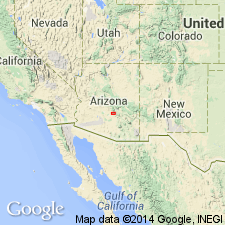
- Usage in publication:
-
- Dogie Spring Member
- Modifications:
-
- Named
- Geochronologic dating
- Dominant lithology:
-
- Tuff
- AAPG geologic province:
-
- Basin-and-Range province
Summary:
Name proposed for the middle member of Superstition Tuff (new). Lies within the 375 sq km interior area of the Superstition cauldron. Intertongues with and is underlain and overlain by nonwelded ash of the Geronimo Head Formation (new). Consists of welded quartz latite tuff that is distinguishable from the Apache Leap Tuff of the Superior area, and from the other members of the Superstition, by a node of quartz > plagioclase, and plagioclase as nearly equal to sanidine. Sphene, zircon, apatite, and magnetite are accessory minerals. Is a simple cooling unit at the type section. Age is Miocene, based on K-Ar date (on biotite) of 18.4 +/-0.6 m.y. Report includes geologic map, columnar section.
Type section: Dogie Spring, 10+ mi northeast of Siphon Draw, Pinal Co., AZ, Basin-and-Range province. Named from exposures at Dogie Spring.
Source: Modified from GNU records (USGS DDS-6; Denver GNULEX).

- Usage in publication:
-
- Dogie Spring Member*
- Modifications:
-
- Adopted
- AAPG geologic province:
-
- Basin-and-Range province
Summary:
Dogie Spring Member of the Superstition Tuff of Stuckless and Sheridan (1971) is adopted [by the USGS]. Age is Miocene.
Source: Modified from GNU records (USGS DDS-6; Menlo GNULEX).
For more information, please contact Nancy Stamm, Geologic Names Committee Secretary.
Asterisk (*) indicates published by U.S. Geological Survey authors.
"No current usage" (†) implies that a name has been abandoned or has fallen into disuse. Former usage and, if known, replacement name given in parentheses ( ).
Slash (/) indicates name conflicts with nomenclatural guidelines (CSN, 1933; ACSN, 1961, 1970; NACSN, 1983, 2005, 2021). May be explained within brackets ([ ]).

